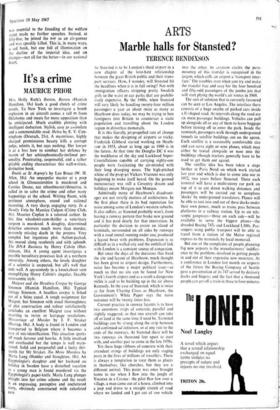Marble halls for Stansted? ARTS
TERENCE BENDIXSON
So Stansted is to be London's third airport in a new chapter of the love-hate relationship between the great British public and their trans- port services. How, I wonder; will Stansted hit the headlines when it is in full swing? NM with immigration officers stripping pretty Swedish girls to the waist or car parks that are prohibi- tively expensive. By the 1980s, when Stansted will very likely be handling twenty-four million passengers a year or about twice as many as Heathrow does today, we may be trying to lure foreigners into Britain to counteract a static population and travelling about the London region in driverless monorails.
It is this literally jet-propelled rate of change that makes the designing of airports so tricky. Frederick Gibberd started working on Heath- row in 1953, about as long ago as 1980 is in the future. At that time the Douglas DC 6 was the workhorse of the sky and Lockheed Super- Constellations capable of carrying eighty-one people were fascinating the air-minded with their long drooping noses. The high-pitched whine of the prop-jet Vickers Viscount was only beginning to make itself heard. On the ground motorocracy was still a Coventry dream and holidays meant Margate not Monaco.
Admittedly many of Heathrow's disadvant- ages are not strictly matters of architecture. In the first place there is its bad reputation for noise among some of London's western suburbs. It also suffers, as Stansted probably won't, from having a runway pattern that broke new ground and it has paid dearly for that innovation. In particular the decision to create an island of terminals, surrounded on all sides by runways with a road tunnel running under one, produced a layout beset with problems. Expansion is as difficult as in a walled city and the umbilical link with London is a constant source of congestion.
But since the days of the decisions that fixed the site and layout of Heathrow, much thought has been given to airport design. Furthermore, noise has become a major political issue—so much so- that no site can be found for New York's fourth airport and as a result a dangerous melee is said to be building up in the air above Kennedy. In the case of Stansted, which is twice as far from Charing Cross as Heathrow, the Government's White Paper says the noise nuisance will be twenty times less.
Current practice in runway layouts is to have two enormous strips of concrete, parallel and slightly staggered, so that two aircraft can take off or land at the same time if need be. Terminal buildings can be strung along the strip between and continued ad infinitum, or at any rate to the ends of the runways. At Stansted there will be two runways six thousand feet apart to start with, and another pair to come in the late 1970s.
Yet these huge ribbons of concrete with their attendant strings of buildings are only staging posts in the lives of millions of travellers. There is always a temptation to treat them as places in themselves, like churches, but they are a different animal. This point was once brought home to me when I flew into the jungle of Yucatan in a Cessna: the pilot flew low over a village, a man came out of a house, climbed into a jeep and drove to a straight stretch of road where we landed and I got out of one vehicle into the other. In aviation circles the para- mountcy of this transfer is recognised in the jargon, which calls an airport a 'transport inter- face.' The troubles start when you try and make the transfer free and easy for the four hundred and fifty-odd passengers of the jumbo jets that will start plying the world's air routes in 1969.
The sort of solution that is currently favoured can be seen at Los Angeles. The interface there consists of a huge swathe of parked cars inside a U-shaped road. At intervals along the road are six main passenger buildings. Vehicles can pull up alongside all or any of them to leave baggage before turning off to enter the park. Inside the terminals, passengers walk through underground tunnels to satellite buildings out on the apron. Each satellite is a reasonably comfortable size and can serve eight or nine planes, which may either be taxied alongside or nose into the buildings (though tractors generally have to be, used to get them out again).
The satellite idea has been taken a stage further at Paris Nord on which work started last year and which is due to come into use in 1972, two years before Stansted. There each terminal will have a multi-storey car park on top of it to cut down walking distances and passengers will be carried out to aeroplane. 'docks' by underground travelators. Planes will be able to taxi into and out of these docks under their own power, much as trains pass between platforms in a railway station. Up to six tele- scopic gangways—three on each side—will be available to serve the biggest planes—the dreaded Boeing 747s and Lockheed L500s. Pas- sengers using public transport will be able to travel from a station of the Metro regional express to the terminals by local monorail.
But one of the complaints of people planning big new airports is the manufacturers' indiffer- ence to the problems involved in getting people in and out of their expensive new monsters. At a conference in London last month on airports of the future the Boeing Company of Seattle gave a presentation of its 747 served by derisory docks and fingers; and the fact that a thousand people can get off a train in three to four minutes


































 Previous page
Previous page